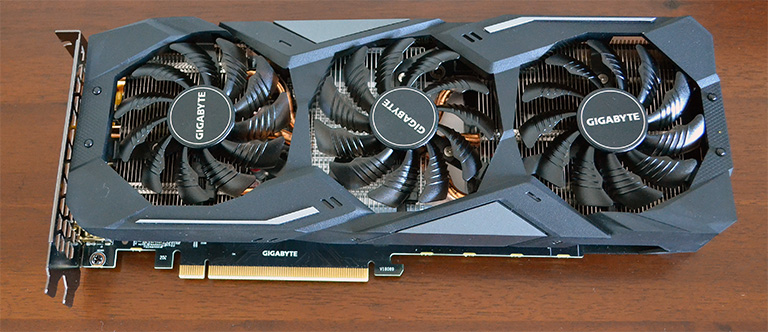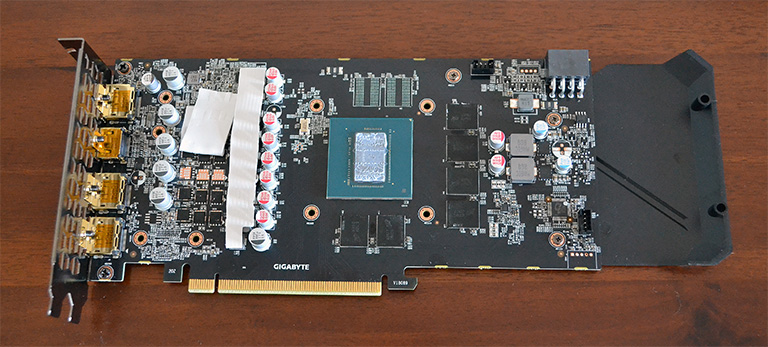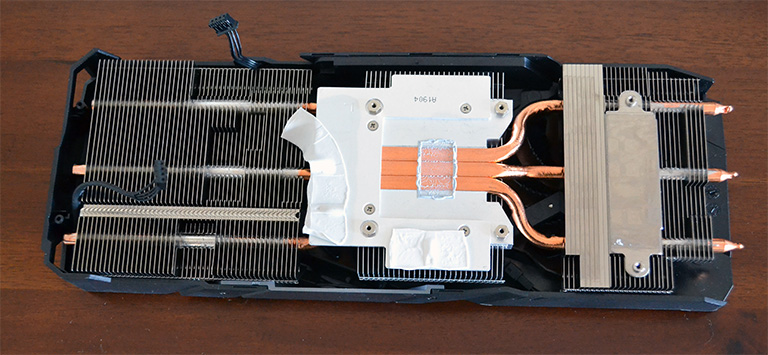Introduction
The GeForce GTX 1660 Ti GPU finds itself in something approaching a no man's land. Though performance is decent at the usual FHD and QHD resolutions, pricing that's too close to the RTX 2060 but comfortably above the likes of Radeon RX 580 makes it a difficult card to recommend. Our advice has been for Nvidia and its partners to reduce entry-level models to around £220, thus bringing the all-important price-to-performance metric to the fore.
Such thoughts aren't stopping all partners from having a go on the GTX 1660 Ti. Gigabyte, for example, has five models that are differentiated by form factor, cooling capacity, speeds, and price. Nearer the premium end is the Gaming OC.
This triple-fan model goes against the grain of what we imagine a mainstream GPU to look like, especially one with a native 120W TDP. Measuring 280mm (l) x 117mm (w) x 40mm (h) it is only very marginally smaller than the company's GeForce RTX 2080 Ti OC. Sure, the cooling is not quite as robust, but we wonder at the logic of such a large card for what should be a Mini-ITX board at best.
As usual, the trio of fans switches off at temperatures below 60°C. The WindForce 3X cooling system requires the middle fan to spin in the opposite (clockwise) direction to the outer two, with the rationale that the air between the fans is always being pushed in the same direction - up for the left-hand duo and down for the right - thereby reducing turbulence and improving heat dissipation.
Build quality on this model is similar to the RTX 20x0 cards, as well, with a plastic shroud that is not as form-fitting as some. The good news is the card retains a strict dual-slot form factor, and for those with an RGB appetite, the Gigabyte logo is backlit and controllable by Fusion software. We'd have preferred the embossed GeForce GTX to have the same RGB treatment, too.
Gigabyte thankfully sticks to the 8-pin power connector present on all other GTX 1660 Ti cards. Notice its positioning, some way in from the right? There's good reason for that.
The PCB measures 225mm long. The extra length is solely there to house the large heatsink. In fact, the card's backplate isn't primarily there to aid cooling - it is plastic rather than metal - rather, the job is to provide adequate stability to the cooler. On the plus side, Gigabyte adds in thermal-transfer strips between all major components.
Notice the two unused memory packages at the top of the GPU. Can we infer that Nvidia may release a mainstream Turing with a full 256-bit memory bus and 8GB of RAM at some point? Perhaps the explanation is more prosaic than that, insofar as these PCBs are also used for the RTX 2070 and RTX 2080. Time will tell.
The heatsink is an exercise in using one that's overkill for the GPU in question. Three heatpipes converge at the centre and make direct contact with the GPU. You can see the contact is excellent by the imprint left from the TIM. This is, we feel, a heatsink good enough to cool a 200W-plus GPU, rather than the nominal 120W here. Its hulking presence ought to bode well for overclocking potential, acoustics and temperature.
All GTX 1660 Ti cards appear to be rated with a 1,500MHz base speed; it is the boost that is different. Perusing all models shows a boost variation between 1,770MHz (default) and 1,890MHz (OC). That's not a huge amount, especially with due knowledge that nobody is overclocking the GDDR6 12Gbps memory. What this means is that there will be less than five per cent difference in the performance of all GTX 1660 Ti cards, irrespective of price and cooling.
Gigabyte's Gaming OC comes in at the top end of this scale - 1,860MHz boost - and our logs show the card actually settles down to an in-game 1,950MHz.
No surprises in the output department, comprising three DisplayPort and a single HDMI; there's no USB Type-C on any GTX 1660 Ti, if you were wondering.
Having an improved cooling solution pushes the price of this card up to £290, or £30 more than stock. Pricing has to be mentioned because for a further £30 you can obtain the cheapest RTX 2060 card, which not only is 15 per cent faster in rasterisation, but has RT and Tensor cores to boot.
It is interesting that Nvidia, undoubtedly aware of the pricing problems associated with GeForce GTX 1660 Ti, has ended (February 25) the Battlefield V or Anthem free game promotion tied to RTX 2060.







